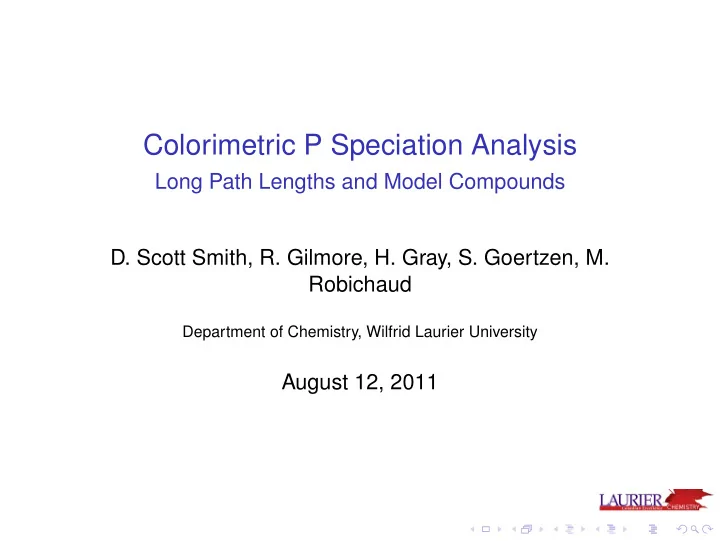

Colorimetric P Speciation Analysis Long Path Lengths and Model Compounds D. Scott Smith, R. Gilmore, H. Gray, S. Goertzen, M. Robichaud Department of Chemistry, Wilfrid Laurier University August 12, 2011
1. Important Issues in P Analysis in Waste Water 1 Low Levels: regulatory requirements on TP potentially below detection using one cm light path Can long path lengths help? 2 Speciation: to optimize P removal need to understand dynamics of P speciation across treatment technologies for example: DOP is resistent to traditional removal methods. Can it be converted to other (more treatable) forms? Does Standard Methods recover speciation of model compounds relevant to wastewater ?
2. Path length Study: Method orthophosphate solutions 1 fixed concentrations to give absorbance of 0.4 for 10 cm or 2 1 m pathlengths vary mixed reagent volume 3 vary colour development time 4 Standard Methods, 1998. Standard methods for the 5 examination of water and wastewater , American Public Health Association, Washington, DC, USA, 20th ed.
3. Ascorbic Acid 10 cm (a) (b) 0.38 0.3 Reagent Volume (mL) Reagent Volume (mL) 1.5 1.5 0.38 0.5 1 1 0.41 1.8 0.8 0.42 1.0 0.43 0.41 0.430.43 0.7 0.2 0.1 0.3 0.44 0.5 0.5 0.430.44 0.3 0.43 0.44 0.3 1.2 0.4 0.43 0.9 0 2 4 6 0 2 4 6 Time (hr) Time (hr) Figure: Contour plot of absorbance (a) and relative (%) standard deviation (b) by the ascorbic acid method with 10 cm light path. Dashed line corresponds to the volume used in Standard Methods.
4. Ascorbic Acid 1 m (a) (b) 0.37 50.6 0.09 29.2 Reagent Volume (mL) Reagent Volume (mL) 1.5 1.5 0.44 1.61 0.09 0.09 1.66 1.66 1 1 0.55 9.90 0.16 0.16 0.23 30.5 30.5 20.5 0.12 31.6 0.31 50.1 0.46 5.63 0.5 0.5 0.65 0.27 0.27 0.30 0.30 0.20 0.20 49.0 27.1 27.1 1.67 1.67 1.50 1.50 0.33 43.9 0.28 67.1 0 5 10 15 20 25 0 5 10 15 20 25 Time (hr) Time (hr) Figure: Contour plot of absorbance (a) and relative (%) standard deviation (b) by the ascorbic acid method with 1 m light path. Dashed line corresponds to the volume used in Standard Methods.
5. Kinetic slice. Ascorbic Acid. 1 m 1 0.8 Absorbance (au) 0.6 0.4 0.2 0 0 20 40 60 80 Time (hr) Figure: 8 µ g P/L standard, 0.5 mL mixed reagent volume.
6. Path length Study: Summary no surprise = long path lengths work fine 1 reduced colour forming reagents = modest 10% increase 2 in sensitivity 1 m pathlength requires long colour development for 3 reproducible signal suggests FIA would be useful ! 4
7. Matrix Effects? (a) (b) 200 4 150 3 orthoP ( µ g P/L) orthoP (mg P/L) 100 2 50 1 0 0 A B C D E F G H Figure: Orthophosphate determinations using external calibrations (light gray bars) and standard addition calibration (dark gray bars). A. Grand River water, B. laboratory tap water, C. final treated wastewater effluent. Subplot (b) correspond to 5 wastewater samples.
8. Anecdote for need to study speciation methods 120 100 80 Other Lab ( µ g P/L) 60 TP 40 tAHPm sRP sAHPm 20 tRP sTP 0 0 50 100 150 200 250 Laurier ( µ g P/L) Figure: caption
9. P Speciation Study: Method Both labs = Standard Methods, 1998. Standard methods 1 for the examination of water and wastewater , American Public Health Association, Washington, DC, USA, 20th ed. but different interpretations of Standard Methods! 2 Ascorbic acid method 3 Various digestion methods (always orthophosphate 4 analysis at the end) polyP 5 AMP 6 phospholipid 7
10. Recoveries 100 ortho-P 90 acid hydrol. 80 persulfate 70 acid-acid 60 % recovery 50 40 30 20 10 0 polyP AMP PL polyP AMP PL AMP PL AMP PL
11. Persulfate Autoclave Program: AMP 110 100 90 80 Phosphorus Recovery (%) 70 60 50 40 30 20 10 0 L30 L50 L75
12. Persulfate Autoclave Program: Phospholipid 110 100 90 80 Phosphorus Recovery (%) 70 60 50 40 30 20 10 0 L30 L50 L75
13. Digestion Method and real waste water 110 100 90 Total Phosphorus Recovery ( µ g/L) 80 70 60 50 40 30 20 10 0 persulfate acid−acid
14. P Speciation Study: Results some model compounds are not recovered by typical 1 methods effect on TP results depends on actual speciation of 2 sample autoclave program needs optimization 3 analysis of model P compounds is important area for 4 future research analysis of real waste water by different digestion 5 methods is important
15. P Acknowledgements HQP current HQP past collaborators Holly Gray Rebecca Gilmore JB Neethling (HDR) Amanda Johnston Kelly Fisher April Gu (Northeastern) Petrease Patton Farah Ateeq Imre Takacs (Dynamita) Monique Robichaud Sudhir Murthy (DCWASA) Wayne Parker (Waterloo) Funding EnviroSim Associates Inc. NSERC OCE WERF Nutrient Challenge DCWASA
Recommend
More recommend